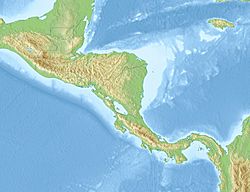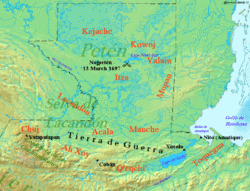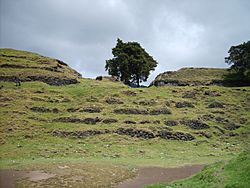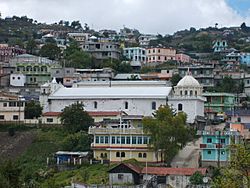Chuj people facts for kids
| Total population | |
|---|---|
| c. 94,000 | |
| Regions with significant populations | |
| 91,391 | |
| Huehuetenango | 89,663 |
| approx. 3,000 | |
| Languages | |
| Chuj, Spanish | |
| Religion | |
| Catholic, Evangelicalist, Maya religion | |
The Chuj are a group of Maya people who live in Guatemala and Mexico. Their special language is also called Chuj. It is part of the Mayan language family.
Most Chuj people live in the Guatemalan area called Huehuetenango. They live mainly in the towns of San Mateo Ixtatán and San Sebastián Coatán. Some also live in nearby parts of the Mexican state of Chiapas. Many Chuj have also moved to Los Angeles in the United States.
The Chuj and their ancestors have lived in this area for about 4,000 years. They first met Spanish explorers, called conquistadores, in the 1530s. However, the Spanish did not fully control them until the 1680s. After Guatemala became independent, the Chuj lost much of their shared land. This led to them becoming very poor. Because of this, they often stood up for their rights and lands.
Contents
What does "Chuj" mean?
|
|
|
| Central America. The red circle shows the homeland of the Chuj in the highlands of northwestern Guatemala and parts of the Mexican state of Chiapas. |
The name Chuj was first used by the Spanish. It is an exonym, which means a name given by outsiders. Some stories say that Spanish soldiers from the Tzeltal group used the word. For them, it meant the loose wool shirt that Chuj men traditionally wore.
The Chuj people have their own names for themselves. These names are based on their hometowns. For example, people from San Mateo Ixtatán call themselves ajSan Matéyo. Those from San Sebastián Coatán are ajSan Sabastyán, and from Nentón, they are ajNenton.
Where the Chuj live and how many there are
The Chuj are a smaller group of Mayan people. They mainly live in Guatemala and Mexico. Since the 1980s, many Chuj have also moved to Los Angeles in the United States.
Most Chuj live in the highlands of Guatemala, in the Huehuetenango area. Their main towns are San Mateo Ixtatán and San Sebastián Coatán. Some also live in parts of Nentón. A smaller number of Chuj live in the Mexican state of Chiapas.
It's hard to know exactly how many Chuj people there are. Estimates range from 30,000 to over 60,000. In Guatemala, San Mateo Ixtatán and San Sebastián Coatán are almost entirely Chuj towns. San Mateo has about 16,000 people, and San Sebastián has about 9,000. About 4,000 Chuj speakers live in Nentón. We don't know the exact number of Chuj in Los Angeles, but some guess it might be similar to the population of San Sebastián Coatán.
In Guatemala, the Chuj are known for standing up for their rights. This comes from a long history of poverty and disagreements over land.
History of the Chuj
|
|
|
| Northern Guatemala when the Spanish first arrived. The red circle shows Chuj territory. |
Ancient times
The Chuj live in an area that is thought to be where the first Proto-Mayan language came from. The Chuj and their ancestors have likely lived there for about 4,000 years. This is when the Proto-Maya language started to split into the many Mayan languages we know today.
Near the modern town of San Mateo Ixtatán, there are old ruins of a Chuj city called Wajxaklajun. This city, also known as Ystapalapán, has mounds and plazas. It dates back to between 600 and 900 A.D.
Like other Maya groups, the Chuj were settled farmers. They grew important crops like maize (corn) and beans. In the 1400s, the Chuj were ruled by the K'iche' group. But in the early 1500s, they managed to become free from K'iche' control.
Spanish arrival
The Spanish began to conquer the Maya lands in Guatemala in 1524. This was when the conquistador Pedro de Alvarado led his army into the region. In 1529, the Chuj city of San Mateo Ixtatán (Wajxaklajun) was given to Gonzalo de Ovalle, a friend of Pedro de Alvarado.
In the 1530s, the Chuj agreed to Spanish rule. In 1549, the first Chuj reduccion was set up in San Mateo Ixtatán. A reduccion was a new town where Spanish missionaries gathered native people. The Chuj of San Mateo Ixtatán continued to protect their way of life. They resisted Spanish control longer than their neighbors. The Spanish had to send many expeditions to keep them peaceful. Over time, the Chuj population decreased due to new diseases and conflicts in the 1500s.
In the late 1600s, a Spanish missionary named Alonso de León said that about eighty families lived in San Mateo Ixtatán. He noted that they did not pay taxes to the Spanish king or attend Catholic church services. He said they were "quarrelsome" and that their religious practices were not truly Christian. They had built a traditional shrine in the hills among old temples. There, they burned special offerings and sacrificed turkeys. Eventually, the Chuj made de León leave San Mateo Ixtatán.
In 1684, Enrique Enriquez de Guzmán, the governor of Guatemala, decided to fully conquer the region. In 1686, the Governor himself came to San Mateo Ixtatán. His troops, led by Captain Melchor Rodríguez Mazariegos, had already taken control of the town. After getting Chuj warriors from nearby villages, including 61 from San Mateo, he launched an invasion of the Lacandon region. This completed the Spanish conquest of the area.
After Spanish rule
Guatemala became independent from Spain in 1821. In the late 1800s, the Guatemalan government allowed Chuj community land to be given to powerful landowners. This started in 1876 when they had to give up land to create the new town of Nenton. In the conflicts that followed, the Chuj managed to keep their shared lands in the high mountains. This helped them gain their reputation for standing up for themselves.
Because they lost much of their land, many Chuj became very poor. They were forced to move to Guatemala's southern coast to find work. As a people, they became farmers or workers who moved from place to place for jobs.
In the years that followed, the Chuj were often involved in uprisings and unrest. This was caused by extreme poverty and feeling wronged because of their lost lands. After the Second World War, political unrest and harsh actions against the Chuj increased. By the 1970s, clashes with the Guatemalan police were common. In the late 1970s and early 1980s, the Chuj focused on protecting their forests. By the 1980s, when Guatemala was ruled by a military government, the Chuj were involved in fighting against the Army. The Army saw them as "internal enemies." During this time, about 25% of the Chuj moved to the United States.
Chuj Culture
Language
The Chuj people traditionally speak a language also called Chuj. It is part of the Q'anjobalan branch of the Mayan languages. It is most similar to Tojolab'al, which is spoken in Mexico. The Chuj now also speak Spanish and are often able to speak both languages.
Even though the Chuj language is still used, children, especially in cities, are learning Chuj less often as their first language. Sometimes, they don't learn it at all.
Marriage and family
The Chuj traditionally have arranged marriages. This means families help choose who their children will marry. Church weddings are not very common because of the cost. Chuj men sometimes practice "bride kidnapping", where a woman is taken, rather than her family being formally asked for her hand in marriage.
Family connections are important on both the mother's and father's sides. Usually, a family lives in a shared area with the husband's brothers and parents. They share chores and childcare within this area. The larger family often owns several small pieces of land, located at different distances from the town center. In San Mateo and San Sebastián, they also have access to shared community land.
Religion and beliefs
Traditional Chuj beliefs are still strong. They believe that most natural places, like hills, rocks, streams, and caves, have spirits. The spirits in caves are often ancestors of the townspeople. People might ask them for help and advice.
Death is seen as a step to becoming an "ancestor." Instructions given by someone who is dying are very important. Spirits are believed to make sure these instructions are followed. If not, they might cause illness or bad luck. People can ask these spirits for advice and help at family altars, cave entrances, hilltops, or at special cross-sites in San Mateo.
Catholicism is also common. In San Mateo, it is syncretic, meaning it mixes with traditional beliefs. In San Sebastián, there is a clear difference between those who follow traditional beliefs and those who follow the more active Catholicism of the Catholic Action group.
Clothing
The Chuj wear special traditional clothes that are different in each town. Men usually wear a short-sleeved wool tunic. It has light embroidery around the neck and arms. Women wear a cotton overblouse with detailed embroidery in red, yellow, green, and black.
See also
 In Spanish: Chuj (etnia) para niños
In Spanish: Chuj (etnia) para niños







